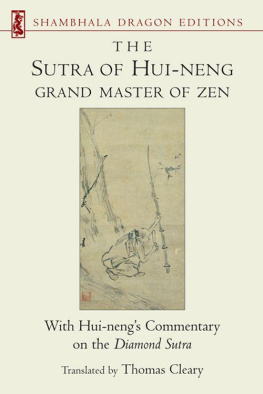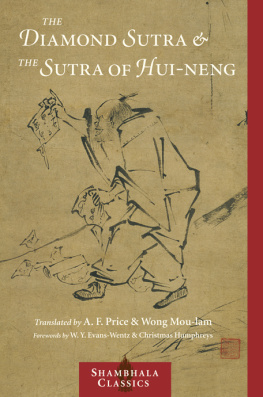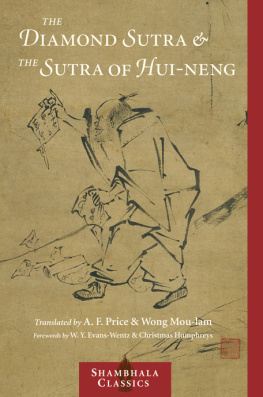Table of Contents
Other works by Red Pine
The Diamond Sutra
The Heart Sutra
The Platform Sutra
In Such Hard Times: The Poetry of Wei Ying-wu
Lao-tzus Taoteching
The Collected Songs of Cold Mountain
The Zen Works of Stonehouse: Poems and
Talks of a 14th-Century Hermit
The Zen Teaching of Bodhidharma
Pu Mings Oxherding Pictures & Verses
TRANSLATORS PREFACE

Z en traces its genesis to one day around 400 B.C. when the Buddha held up a flower and a monk named Kashyapa smiled. From that day on, this simplest yet most profound of teachings was handed down from one generation to the next. At least this is the story that was first recorded a thousand years later, but in China, not in India. Apparently Zen was too simple to be noticed in the land of its origin, where it remained an invisible teaching. It was not until an Indian monk named Bodhidharma brought it to the Middle Kingdom, that Zen finally made landfall. This bearded barbarian who became Chinas First Zen Patriarch was only slightly more perceptible than Kashyapas smile, but he was perceptible, appearing in a brief biographical notice recorded by his disciple, Tan-lin (506574), and in a more extensive biography by Tao-hsuan (596667) in his Hsukaosengchuan. But the event that brought Bodhidharma to the attention of historians and hagiographers alike occurred in or around 534 when he chose Hui-ko as his successor and handed him a copy of the Lankavatara. Bodhidharma told him everything he needed to know was in this book, and Zen and the Lanka have been linked ever since, if they were not already linked in India.
The title of this book that contained everything Hui-ko needed to know is a combination of the Sanskrit words lanka and avatara. Chinese commentators say lanka means unreachable. Maybe it does, but I dont know what they base this on. The only definition I can find is that the word refers to the island we now call Sri Lanka or to its principal town. Perhaps the name was derived from the root lankh or lang, which mean to go to or to go beyond respectively. But if that were true, it would be reachable. And according to Buddhist chronicles, it was, as the Buddha himself reached Lanka on three occasions, one of them being to transmit the teaching of this sutra. Such chronicles, however, were compiled centuries after the Buddhas reported visits. The earliest recorded appearance of Buddhism on the island did not occur until 150 years after the Buddhas Nirvana, when Mahinda, the son of King Ashoka (r. 250 B.C.), introduced the Dharma to the islands inhabitants. As for the second part of the title, avatara, this means to alight or descend, and usually refers to the appearance of a deity upon earthand from which we get the word avatar. Thus, the sutras title could be translated as Appearance on Lanka, referring to the Buddhas reputed visit to the island.
Since the sutra first appeared in China in the form of a Sanskrit text at the beginning of the fifth century, it was probably composed in India in the middle of the previous century, give or take a decade or two. And since the first two monks who brought Sanskrit copies to China were both from what was then called Central India (the Ganges watershed of Uttar Pradesh), this would be a likely place for its origin. Also, unlike other Mahayana sutras, which were written in Buddhist Hybrid Sanskrit, the Lankavatara was written in Classical Sanskrit. Classical Sanskrit was the language of Brahmans and of the court. And in the middle of the fourth century, the court was located in the Central Indian city of Patna, on the banks of the Ganges. This was the court of Samudragupta the Great (r. 335375).
Samudragupta was a devout Hindu, but he also respected other religious traditions and once granted permission to King Meghavarna, the ruler of Lanka, to construct a Buddhist monastery at Bodh Gaya, the place of the Buddhas Enlightenment. Perhaps it was such an event that inspired our author to locate his text on the island. And perhaps he composed his work hoping that it might reach the ears or eyes of this cakravartin, or universal monarch, which was how Samudragupta often referred to himselfand to whom the author of the Lanka also refers in a number of places. In addition to his military prowess, Samudragupta was also a skilled musician, and the detailed description of melodic modes near the beginning of Chapter One must have been written with someone in mind.
Another possibility for the sutras place of origin would be Lanka itself or the nearby mainland. Although Theravada has been the dominant form of Buddhism on the island for the past thousand years, prior to that it was a stronghold of the Yogacara school. And this sutra was clearly addressed to an audience familiar with the formative concepts of this school of Buddhism. But what sets the Lanka apart is that it points readers beyond the teachings of the early Yogacara to their own minds. Pointing directly at the mind was and still is a hallmark of the Zen school of Buddhism. And the man who brought Zen to China was from the area just north of Lanka near the seaport of Kanchipuram. Of course, most scholars doubt that Zen ever existed in Indiaand thus they necessarily see Bodhidharma as an invention of Chinese hagiographers. They contend that Zen was of Chinese origin, where it first appears in the sixth and seventh centuries and where it then conjures its Indian origin and the person of Bodhidharma to provide it with historical legitimacy.
This is an argument that has given rise to much debate and not one to which I have anything salutary to add, other than to ask: if Zen originated in China, where did this text come from? If there ever was a sutra that presented the underlying teaching of Zen, this is it. It is unrelenting in its insistence on the primacy of personal realization and is unlike any other teaching attributed to the Buddha in this regard. D. T. Suzuki, the previous translator of the Lankavatara, put it this way, The reason why Bodhidharma handed this sutra to Hui-k o as containing the essence of Zen Buddhism must be sought in this, that the constant refrain of the Lankavatara is the all-importance of an inner perception ( pratyamagati ) or self-realization ( svasiddhanta ). ( Studies in the Lankavatara Sutra, pg. 102 )
Indeed, this is the constant refrain of the sutra. But it isnt just about Zen; it is firmly rooted in what would later become known as Yogacara Buddhism as well. And it also focuses on the bodhisattva path that still dominates Mahayana Buddhism. But it does all this far beyond the normal venues of Mahayana discourse on the distant island of Lanka, where the sutra opens with the Buddha instructing one of ancient Indias serpent kings in the Dharma. As the Buddha reappears from the serpent kings watery realm, Ravana, ruler of Lanka, invites him to his nearby capital in hopes of a similar discourse. The Buddha agrees and proceeds to instruct the king in the illusory nature of what Buddhists call dharmas, all those things we think of as real, be they tangible, intangible, or merely imagined.
Following this introductory chapter, Mahamati then rises from among the assembled bodhisattvas and presents the Buddha with a gauntlet of questions, to which the Buddha responds by telling him that the very terms in which his questions are posed are projections of his own and others imaginations and as such are tantamount to pie in the sky. A statement about pie thus becomes a statement about no pie.













